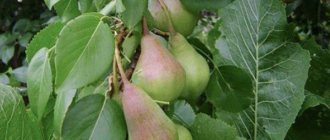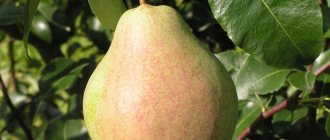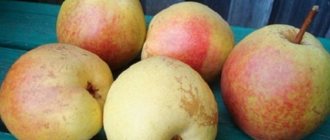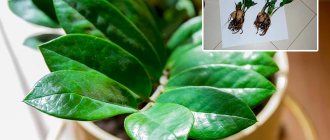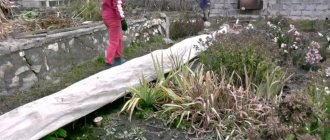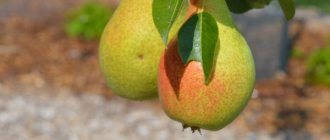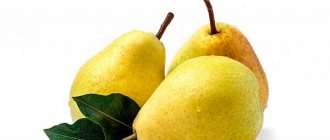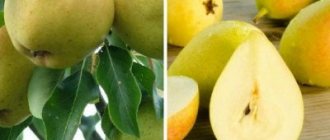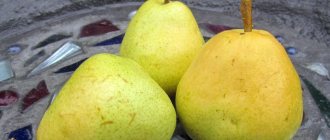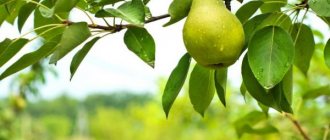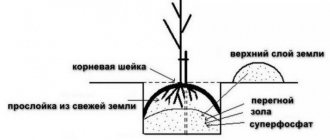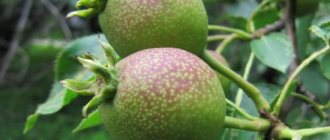Description of the variety
Svarog pear belongs to the varieties of early autumn ripening. Thanks to its good frost resistance, the variety is excellent for growing in the harsh Siberian climate.
Characteristics of wood
Trees of this variety are characterized by medium growth vigor. An adult pear reaches a height of 3-3.5 meters. The crown of the tree tends to thicken and has a rounded shape. The trunk and main branches are covered with flaky gray bark. Young shoots have a brownish color. The foliage is small, light green, oblong in shape. The surface of the leaf blade is wrinkled and slightly pubescent.
Description of fruits
Pear Svarog.
Pears are small and average weight is 75-80 grams. The fruits are broadly pear-shaped in shape. Once ripe, pears turn yellow. There are many small green subcutaneous dots on the surface. The blush is small and appears in the form of blurry, reddish stripes.
The taste of the fruits is juicy, sweet and sour, semi-oily, with a weak aroma.
Fruit ripeness occurs at the end of September - beginning of October. In refrigerated conditions, the harvested crop can be stored until the end of December.
How to plant a tree on your property correctly
In order for the landing to be successful, it must be carried out correctly - and you need to pay attention to the following points:
- choosing a place where the fruit tree will grow;
- selection of high-quality and suitable seedlings.
Site selection and land preparation
Secluded and sheltered areas of the garden with sufficient sunlight are suitable for growing pears. It is optimal to place trees close to the house or utility room, the walls of which can shelter the tree from strong gusts of wind.
Ruscus or broom photo Planting and care at home Propagation by cuttings and seeds
At the planting site, groundwater should not be closer than 2–3 m to the surface, since the soil may be too wet, which can negatively affect the root system and even lead to its rotting. Svarog can be grown in any region, but it is worth noting that this variety is successfully cultivated in the northern regions.
How to choose the right seedlings
The choice of planting material is an important point, during which it is necessary to pay attention to the following qualities of seedlings:
- Size of the root system - it should be dense and well developed, which will contribute to good growth of the tree.
- Height - the optimal size is 70 cm or more.
- Age: must be no more than 2 years old.
- When examined, its surface should be free of damage, deformation, and stains that may indicate damage by pests or diseases.
How to prepare and plant seedlings on the site
Before proceeding directly to the planting process, it is recommended to prepare the seedlings, which involves:
- removal of damaged areas of rhizome;
- soaking them in mash made with heteroauxin.
Next you should start preparing the planting hole. This process must be taken care of in advance, several weeks before planting the seedling, which will help compact the top layer of soil.
A hole is dug about 80–100 cm in diameter and 60–80 cm deep. Organic fertilizers are added to the soil at the rate of about 8 kg per tree.
Agricultural technology for planting pears:
- In the planting hole, it is necessary to form an earthen mound from prepared and fertilized soil.
- A seedling is placed on an earthen embankment and its rhizome is straightened.
- A peg is driven into the planting hole, which will serve as a support for the tree. Its height should be about 40 cm.
- The root collar should rise 6 cm above ground level.
- The rhizome is covered with earth, which is then lightly compacted.
- It is necessary to organize a hole for watering (40 cm in diameter) - this will allow watering to be done in a more gentle way for the tree. After planting, 4–5 buckets of water are poured into it.
- After watering, it is necessary to fertilize the seedling with humus and mulch the planting site with peat to retain moisture.
Reviews
Tamara
Divnogorsk
I have been growing this variety of pear for about 15 years. The tree did not grow very tall and there were very few fruits on it in the first years. Now the harvest is certainly better, but when compared with other varieties that grow in my garden, there are not enough fruits.
Sergey
Kemerovo
The tree is perfect for lazy gardeners. I personally visit the dacha only a few times a year, and even in our harsh climate, the pear successfully grows and bears fruit, practically without my participation.
Eugene
Barnaul
Although pears are not large, they are not inferior in taste to other varieties, and they are stored in the cellar for quite a long time. The harvest from the tree is not particularly generous, but it is enough for a family of four.
Advantages and disadvantages
If you compare the autumn pear variety Svarog with more productive varieties, you can find many disadvantages in it:
- insufficiently large fruit size;
- the tendency of the crown to thicken and the need for frequent pruning;
- the trees are demanding of the soil (it should not be dry or excessively wet);
- satisfactory resistance to some pests;
- The self-fertility of the variety is only partial, which requires additional pollination.
The pear also has advantages. These include:
- good winter hardiness;
- immunity to fungal diseases;
- good presentation of ripe fruits;
- excellent taste;
- quite a long shelf life (refrigerated for 3 months);
- versatility of fruits (possibility of processing);
- their inclination to shedding, spoilage, and rotting.
As you can see, the variety still has more advantages than disadvantages, and many gardeners speak very highly of it. And to ensure that the harvest is always high, select good pollinators for the pear - they will not only increase productivity, but also improve the quality characteristics of the fruit.
Landing
Svarog seedlings take root best when planted in the spring and in a pre-prepared hole. By clicking on the links below, you can find a lot of useful information on this issue.
How to plant a pear tree correctly
At what distance to plant pears?
How to choose pear seedlings
How to replant a pear
Care
Due to the fact that the crown of Svarog trees is prone to thickening, it is necessary to regularly prune and shape. More recommendations for growing pears of this variety can be found in the articles selected below.
How to care for a pear Pruning a pear Pruning a columnar pear Treating a pear from diseases and pests Feeding a pear How to water a pear
Autumn pear Svarog
Origin of the variety
Autumn pear Svarog is an early autumn pear variety, artificially bred at the Scientific Research Institute of Horticulture of Siberia named after.
M.A. Lisavenko as a result of crossing the Ussuri pear and the Bere Bosc variety (French variety) in 1969. Authorship is assigned to domestic scientist-breeders I.P. Kalinina, I.A. Puchkin and G.N. Baykova. The variety was submitted to State Variety Testing in 1993, and three years later it was zoned in the West Siberian (Altai Territory), East Siberian (Krasnoyarsk Territory) and Volga-Vyatka regions.
Application
The fruits of the Svarog variety are universal in consumption: they are tasty both fresh (as they are often eaten) and processed. So, if desired, you can make jam, compote, juice, dried fruit, jam or wine from the harvest.
Features of growth
Trees of the Svarog variety are considered medium-sized. Please note that the crown of the Svarog tree is very prone to thickening!
Climatic conditions
The autumn pear Svarog is distinguished by its very high resistance to frost.
Diseases/pests
The leaves and fruits of the Svarog pear tree are highly resistant to scab and fungal diseases.
Care
In addition to standard care measures, Svarog needs regular, very careful pruning of the crown - it is very lush. If this measure is neglected, the yield may decrease.
Bark
On the trunk and main branches the bark is flaky, brownish-gray. The shoots are slightly curved and covered with brownish-red bark. Light pubescence is noticeable at the tips of the shoots.
Leaves
The leaves are small, light green, elliptical in shape, the apex is twisted with a screw. The surface of the leaf blade is wrinkled, with barely noticeable hairiness.
Fruit
Autumn pear Svarog bears fruit in small pears, their weight usually varies from 70 to 80 grams, but the largest specimens can reach 100 grams. The fruits have a blunt cone or broad pear shape. The skin is dull, tender, with very noticeable small subcutaneous dots. At the time of harvesting ripeness, the fruits are green, and during the period of consumer ripeness they become yellow. Also, a blurred striped red blush is “scattered” across the entire surface of the fruit. The stalks are curved and medium in length. The funnel is narrow, smooth, small. The saucer is wide and of medium depth. The calyx does not fall off. The heart is small, ovoid in shape. The seed chambers are closed and medium in size. The subcup tube is almost invisible. The seeds are large, ovoid in shape. Brown color.
The flesh is cream-colored. Their consistency is very tender, juicy, semi-oily. The aroma is pleasant, but not strong. The taste of Svarog pears is sour-sweet, with a pleasant aftertaste.
Chemical composition: total sugars (9.5%), titratable acids (0.44%), ascorbic acid (9.5 mg/100 g), tannins (170 mg/100 g), P-active compounds (125 mg /100 g).
You can pick the fruits from the branches at the end of September, but consume them a little later - from the beginning of October. At room temperature, pears will not last more than 3 weeks, but under the best storage conditions (refrigerator or cellar), they can remain fresh for up to 3 months.
Diseases and pests
The variety has good resistance to various diseases, however, to maintain immunity, it is very important to carry out regular prevention. In the selection of articles below, you can find detailed instructions on protecting the plant.
Dangerous Pear Pests
Pears often suffer from pests, they affect the leaves, bark and fruits.
In this article, we have selected 11 of the most harmful insects that harm pear trees, and also ways to destroy them.
Diseases of pear trees
To get what they cherish, gardeners have to work hard, and the reason for this is pear diseases.
Read about 19 common pear diseases and how to combat them.
